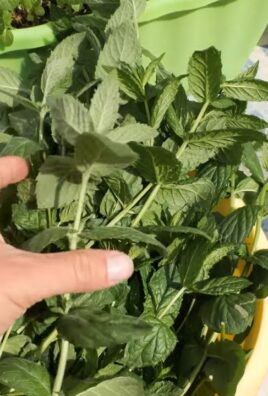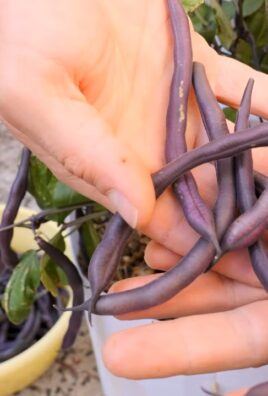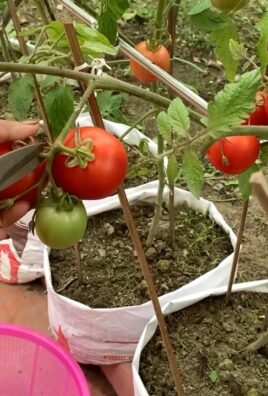Grow Asparagus Kitchen Garden: Ever dreamt of snipping fresh, vibrant asparagus spears right from your own backyard, ready to grace your dinner plate? I know I have! Forget those pricey, sometimes-wilted bundles at the grocery store. This isn’t just about saving money; it’s about connecting with nature and enjoying the unparalleled flavor of homegrown goodness.
Asparagus has a rich history, dating back to ancient Greece and Rome, where it was prized for its medicinal properties and delicate taste. Imagine, emperors and philosophers savoring the same vegetable you can now cultivate just steps from your kitchen! For centuries, asparagus has been a symbol of spring and renewal, a welcome sign after the long winter months.
But let’s be honest, growing asparagus can seem intimidating. That’s where these DIY tricks and hacks come in! Many people are put off by the perceived difficulty and time commitment. But I’m here to tell you, with a little know-how, you can successfully grow asparagus kitchen garden, even if you’re a beginner gardener. This article will demystify the process, offering simple, step-by-step instructions and clever tips to ensure a bountiful harvest. Get ready to transform your garden into an asparagus oasis!

Growing Asparagus in Your Kitchen Garden: A Beginner’s Guide
Asparagus, that delicious and elegant spring vegetable, might seem intimidating to grow at home. But trust me, with a little patience and the right approach, you can absolutely cultivate your own asparagus patch right in your kitchen garden! It’s a long-term investment, as asparagus takes a few years to mature, but the rewards – fresh, flavorful spears right at your fingertips – are well worth the wait. I’m going to walk you through everything you need to know to get started.
Choosing the Right Location and Preparing the Soil
Asparagus needs a sunny spot and well-drained soil to thrive. Think about where you can dedicate a permanent space in your garden, as asparagus plants can live for 15-20 years!
* Sunlight: Asparagus needs at least 6-8 hours of direct sunlight per day. The more sun, the better!
* Soil Drainage: Asparagus roots hate sitting in soggy soil. Make sure your chosen spot drains well. If you have heavy clay soil, you’ll need to amend it significantly.
* Soil pH: Asparagus prefers a slightly acidic to neutral soil pH, ideally between 6.5 and 7.0. You can test your soil pH with a simple soil testing kit available at most garden centers.
Now, let’s get down to the nitty-gritty of soil preparation. This is arguably the most important step, so don’t skimp on it!
1. Clear the Area: Remove any existing grass, weeds, rocks, and debris from the area where you plan to plant your asparagus.
2. Dig a Trench: Dig a trench that is approximately 12 inches wide and 6-8 inches deep. The length of the trench will depend on how many asparagus crowns you plan to plant.
3. Amend the Soil: This is where the magic happens! Asparagus is a heavy feeder, so you need to enrich the soil with plenty of organic matter. I recommend mixing in the following:
* Compost: Add a generous amount of well-rotted compost to the trench. Compost improves soil drainage, adds nutrients, and helps retain moisture.
* Aged Manure: Aged manure is another excellent source of nutrients. Make sure it’s well-aged to avoid burning the asparagus roots.
* Bone Meal: Bone meal is rich in phosphorus, which is essential for root development.
* Potash: Potash helps with overall plant health and disease resistance.
4. Mix Thoroughly: Use a garden fork or shovel to thoroughly mix the compost, manure, bone meal, and potash into the soil in the trench. You want to create a rich, loose, and well-draining planting medium.
5. Mound the Soil: Create a small mound of soil down the center of the trench. This mound will support the asparagus crowns and help with drainage.
Choosing and Planting Asparagus Crowns
You have two main options for starting asparagus: seeds or crowns. While you can grow asparagus from seed, it takes much longer (an extra year or two) to get a harvestable crop. I highly recommend starting with crowns, which are one-year-old or two-year-old asparagus plants.
* Choosing Crowns: Look for healthy, plump crowns with well-developed roots. Avoid crowns that are dry, shriveled, or moldy.
* Variety Selection: ‘Jersey Knight’ is a popular and reliable variety that is known for its high yields and disease resistance. ‘Purple Passion’ is another interesting variety that produces beautiful purple spears.
Here’s how to plant your asparagus crowns:
1. Soak the Crowns: Before planting, soak the asparagus crowns in a bucket of water for about 30 minutes. This will help rehydrate the roots.
2. Position the Crowns: Place the asparagus crowns on top of the soil mound in the trench, spacing them about 12-18 inches apart. The crown should be positioned with the roots spread out around it.
3. Cover the Crowns: Gently cover the asparagus crowns with about 2-3 inches of soil. Be careful not to bury the crowns too deeply, as this can prevent them from sprouting.
4. Water Thoroughly: Water the newly planted asparagus crowns thoroughly to settle the soil and provide moisture.
Caring for Your Asparagus Patch
Asparagus requires consistent care to thrive. Here’s what you need to do:
1. Watering: Water your asparagus patch regularly, especially during dry periods. Asparagus needs consistent moisture to produce healthy spears. Aim for about 1 inch of water per week.
2. Weeding: Keep your asparagus patch free of weeds. Weeds compete with asparagus for nutrients and water. Hand-pull weeds regularly or use a hoe to cultivate the soil around the plants.
3. Fertilizing: Fertilize your asparagus patch in early spring and again in mid-summer. Use a balanced fertilizer or a fertilizer specifically formulated for vegetables. Follow the instructions on the fertilizer package.
4. Mulching: Apply a layer of mulch around your asparagus plants to help retain moisture, suppress weeds, and regulate soil temperature. Organic mulches like straw, wood chips, or shredded leaves are excellent choices.
5. Pest and Disease Control: Asparagus is relatively pest-resistant, but it can be susceptible to certain pests and diseases, such as asparagus beetles and crown rot. Inspect your plants regularly for signs of pests or diseases and take appropriate action if necessary. Insecticidal soap or neem oil can be used to control asparagus beetles. Good soil drainage is essential for preventing crown rot.
Harvesting Your Asparagus
This is the part you’ve been waiting for! But remember, patience is key. Don’t harvest any spears during the first year after planting. This allows the plants to establish a strong root system.
* Year Two: You can harvest a few spears for a short period (about 2-3 weeks) in the second year.
* Year Three and Beyond: In the third year and beyond, you can harvest asparagus for a longer period (about 6-8 weeks) in the spring.
Here’s how to harvest asparagus:
1. Harvest When Spears are 6-8 Inches Tall: Harvest asparagus spears when they are about 6-8 inches tall and the tips are still tightly closed.
2. Cut or Snap the Spears: You can either cut the spears at ground level with a sharp knife or snap them off by hand. If you snap them off, they will break at the point where they are naturally tender.
3. Harvest Regularly: Harvest asparagus spears regularly throughout the harvest season to encourage continued production.
4. Stop Harvesting: Stop harvesting asparagus when the spears become thin and spindly. This indicates that the plants are starting to exhaust their energy reserves.
Fern Care After Harvest
After the harvest season is over, the asparagus plants will produce ferns. These ferns are essential for replenishing the plants’ energy reserves for the following year.
1. Let the Ferns Grow: Allow the ferns to grow and mature throughout the summer and fall. Do not cut them back until they turn brown in the late fall or early winter.
2. Fertilize Again: Fertilize your asparagus patch again in mid-summer to provide the plants with the nutrients they need to support fern growth.
3. Cut Back the Ferns: In the late fall or early winter, after the ferns have turned brown, cut them back to ground level. This will help prevent diseases and pests from overwintering in the asparagus patch.
4. Mulch Again: Apply a fresh layer of mulch around your asparagus plants to protect them from the cold winter weather.
Troubleshooting Common Asparagus Problems
Even with the best care, you might encounter some problems with your asparagus patch. Here are a few common issues and how to address them:
* Thin Spears: Thin spears can be caused by a variety of factors, including insufficient watering, poor soil fertility, or over-harvesting. Make sure you are watering your asparagus patch regularly, fertilizing it properly, and not harvesting too many spears.
* Yellowing Ferns: Yellowing ferns can be a sign of nutrient deficiency, disease, or pest infestation. Check your soil pH and nutrient levels, inspect your plants for signs of disease or pests, and take appropriate action if necessary.
* Asparagus Beetles: Asparagus beetles are small, colorful beetles that can damage asparagus spears and ferns. Hand-pick the beetles off your plants or use insecticidal soap or neem oil to control them.
* Crown Rot: Crown rot is a fungal disease that can cause the asparagus crowns to rot. Good soil drainage is essential for preventing crown rot. Avoid overwatering your asparagus patch and make sure the soil is well-draining.
Extending the Harvest
Want to enjoy asparagus for even longer? Here are a few tips for extending your harvest season

Conclusion
So, there you have it! Growing your own asparagus kitchen garden isn’t just a whimsical dream; it’s a tangible reality that can bring fresh, flavorful spears right to your table for years to come. We’ve walked you through the process, from selecting the right crowns to nurturing your plants for optimal growth. The initial investment of time and effort is undoubtedly worth the long-term reward of having a sustainable source of this delicious and nutritious vegetable.
Why is this DIY trick a must-try? Because it empowers you to control the quality of your food, reduce your carbon footprint, and experience the unparalleled satisfaction of harvesting something you’ve nurtured from the ground up. Store-bought asparagus simply can’t compare to the vibrant flavor and crisp texture of freshly picked spears from your own garden. Plus, you’ll avoid the pesticides and herbicides often used in commercial farming.
But the beauty of gardening lies in its adaptability. Feel free to experiment with different asparagus varieties to find your personal favorite. ‘Jersey Knight’ is a popular choice for its high yield and disease resistance, while ‘Purple Passion’ offers a unique color and sweeter flavor. Consider companion planting to enhance growth and deter pests. Marigolds, for example, are known to repel nematodes, while basil can help deter asparagus beetles.
Don’t have a large garden space? No problem! Asparagus can also be grown in raised beds or large containers, making it accessible to apartment dwellers and those with limited outdoor space. Just ensure your container is deep enough to accommodate the plant’s extensive root system.
We understand that embarking on a new gardening venture can feel daunting, but we encourage you to take the plunge. The rewards are well worth the effort. Imagine the pride you’ll feel serving a dish featuring asparagus you’ve grown yourself. Think of the money you’ll save by reducing your grocery bill. And consider the health benefits of consuming fresh, homegrown produce.
Growing your own asparagus kitchen garden is more than just a gardening project; it’s an investment in your health, your well-being, and your connection to nature. So, grab your gardening gloves, prepare your soil, and get ready to enjoy the bounty of your own asparagus patch.
We’re eager to hear about your experiences! Share your tips, tricks, and triumphs in the comments below. Let’s create a community of asparagus enthusiasts and inspire others to embrace the joy of homegrown goodness. Don’t forget to tag us in your photos on social media using #HomegrownAsparagus. Happy gardening!
Frequently Asked Questions (FAQ)
What is the best time of year to plant asparagus crowns?
The ideal time to plant asparagus crowns is in early spring, typically a few weeks before the last expected frost. This allows the plants to establish their root systems before the heat of summer arrives. In warmer climates, you can also plant in the fall. The key is to avoid planting when the ground is frozen or waterlogged.
How long does it take for asparagus to produce spears after planting?
Patience is key when growing asparagus! It typically takes two to three years after planting crowns before you can harvest a significant crop. In the first year, allow the plants to establish themselves without harvesting any spears. In the second year, you can harvest sparingly, picking only the thickest spears for a few weeks. By the third year, you can enjoy a more substantial harvest. This waiting period allows the plants to develop a strong root system, which is essential for long-term productivity.
What type of soil is best for growing asparagus?
Asparagus thrives in well-drained, sandy loam soil with a pH between 6.5 and 7.5. The soil should be rich in organic matter. Before planting, amend the soil with compost or well-rotted manure to improve drainage and fertility. Avoid heavy clay soils, as they can become waterlogged and lead to root rot. If you have clay soil, consider growing asparagus in raised beds or containers.
How much sunlight does asparagus need?
Asparagus requires at least six to eight hours of direct sunlight per day to thrive. Choose a planting location that receives ample sunlight throughout the growing season. Insufficient sunlight can result in weak, spindly spears and reduced yields.
How often should I water asparagus plants?
Water asparagus plants regularly, especially during dry periods. Aim to keep the soil consistently moist but not waterlogged. Water deeply and less frequently, rather than shallowly and more often. A good rule of thumb is to water when the top inch of soil feels dry to the touch. During the dormant season (fall and winter), reduce watering.
How do I fertilize asparagus plants?
Asparagus is a heavy feeder and benefits from regular fertilization. In early spring, before the spears emerge, apply a balanced fertilizer (e.g., 10-10-10) according to the package instructions. You can also side-dress the plants with compost or well-rotted manure. Avoid over-fertilizing, as this can lead to excessive foliage growth at the expense of spear production.
How do I harvest asparagus spears?
Harvest asparagus spears when they are about 6 to 8 inches tall and about as thick as your finger. Use a sharp knife to cut the spears at ground level. Avoid damaging the surrounding spears or the crown of the plant. Harvest spears regularly throughout the harvest season, which typically lasts for six to eight weeks.
What are some common pests and diseases that affect asparagus?
Asparagus beetles are a common pest that can damage the foliage and spears. Handpicking the beetles or using insecticidal soap can help control infestations. Asparagus rust is a fungal disease that can cause orange pustules on the foliage. Ensure good air circulation around the plants and avoid overhead watering to prevent rust. Fusarium wilt is another fungal disease that can cause yellowing and wilting of the plants. Choose disease-resistant varieties and practice crop rotation to minimize the risk of Fusarium wilt.
How do I prepare asparagus plants for winter?
In the fall, after the foliage has turned yellow and died back, cut the ferns down to ground level. Remove any debris from the area to prevent the spread of disease. Apply a layer of mulch, such as straw or shredded leaves, to protect the crowns from freezing temperatures. In colder climates, you may need to provide additional winter protection, such as covering the plants with a tarp or blanket.
Can I grow asparagus in containers?
Yes, asparagus can be grown in containers, but you’ll need a large, deep container to accommodate the plant’s extensive root system. Choose a container that is at least 12 inches deep and 12 inches wide. Use a well-draining potting mix and ensure the container has drainage holes. Water and fertilize regularly. Container-grown asparagus may require more frequent watering and fertilization than plants grown in the ground.
What are some good companion plants for asparagus?
Several plants can benefit asparagus when planted nearby. Tomatoes, basil, parsley, and marigolds are all good companion plants for asparagus. Tomatoes help deter asparagus beetles, while basil and parsley attract beneficial insects that prey on asparagus pests. Marigolds repel nematodes, which can damage asparagus roots. Avoid planting asparagus near onions, garlic, or potatoes, as these plants can inhibit asparagus growth.
How long will my asparagus patch last?
With proper care, an asparagus patch can last for 15 to 20 years or even longer. The key is to provide the plants with adequate sunlight, water, and nutrients, and to protect them from pests and diseases. Regular harvesting and proper winter care will also help prolong the life of your asparagus patch.




Leave a Comment